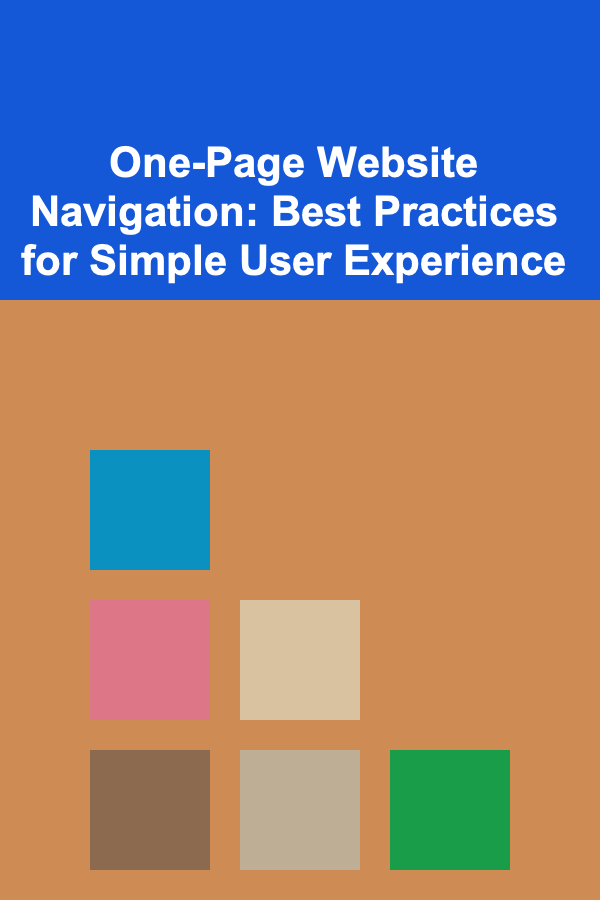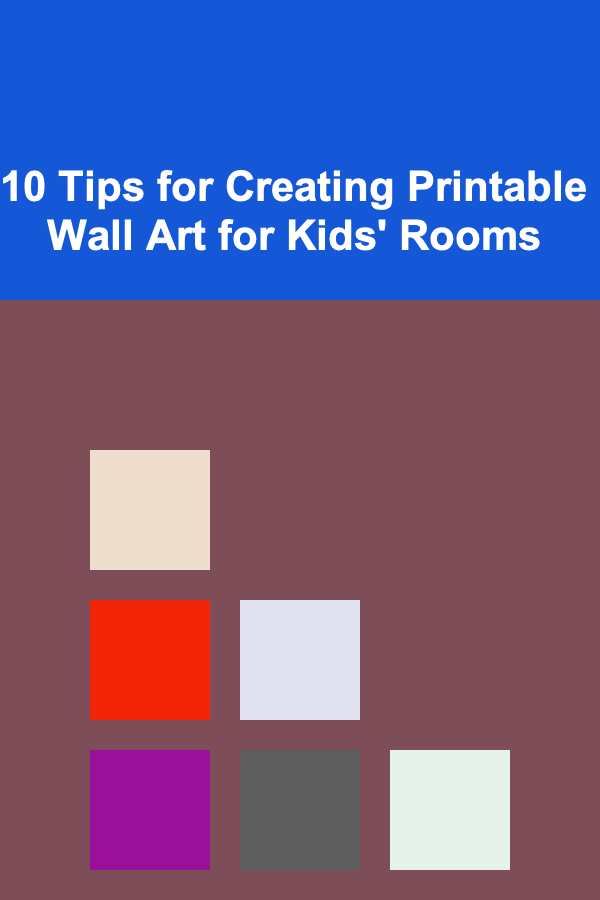
One-Page Website Navigation: Best Practices for Simple User Experience
ebook include PDF & Audio bundle (Micro Guide)
$12.99$11.99
Limited Time Offer! Order within the next:

In today's fast-paced digital world, website design plays a pivotal role in how users interact with content. When it comes to one-page websites, the challenge is to create a user experience that is seamless, engaging, and easy to navigate. One-page websites have gained significant popularity for their simplicity and effectiveness in delivering a concise message. However, achieving a smooth navigation system within the confines of a single page requires careful planning, thoughtful design, and adherence to best practices.
In this article, we will explore the best practices for one-page website navigation and how these practices contribute to an enhanced user experience. From structuring the page effectively to implementing intuitive interaction elements, we'll delve into the key strategies that designers and developers can employ to ensure that their one-page websites are not only visually appealing but also functional and easy to navigate.
Understanding One-Page Website Navigation
Before diving into best practices, it's important to understand what defines navigation on a one-page website. Unlike traditional websites with multiple pages, a one-page website consolidates all its content into a single scrolling page. This content can range from informational text, images, and videos to contact forms, pricing sections, and calls to action. The navigation system on these websites is designed to guide users through different sections without overwhelming them or requiring them to leave the page.
Effective navigation is critical because it helps users find relevant information quickly and effortlessly. It keeps the user engaged by offering a smooth, intuitive journey from one section to another. Whether it's for an event, a product launch, or a personal portfolio, a well-structured one-page website can leave a lasting impression on users.
Key Components of One-Page Website Navigation
In the context of a one-page website, navigation consists of several key components, each serving a specific function. The following are some essential elements of one-page website navigation:
- Navigation Menu
- Anchor Links
- Sticky Navigation
- Scroll Indicators
- Content Layout and Structure
- Visual Hierarchy
- Interactive Elements
- Mobile Responsiveness
These components work together to create a smooth and fluid navigation experience. Let's take a deeper look at each of these elements and explore best practices for designing a simple yet effective user navigation system.
Navigation Menu: Keeping It Simple and Clear
The navigation menu is the cornerstone of one-page website navigation. It acts as the guide, helping users find the specific section they're looking for. Since one-page websites don't have multiple pages, the navigation menu typically features a set of anchor links that correspond to different sections of the page.
Best Practices for Navigation Menus:
- Limit the Number of Links: Too many links can overwhelm users and detract from the overall user experience. Ideally, limit the menu to five or six links. These links should represent the most important sections of the page, such as "About," "Services," "Portfolio," "Testimonials," and "Contact."
- Use Clear Labeling: The language used in the menu should be simple, clear, and self-explanatory. Instead of using vague terms like "More" or "Info," be specific. For example, if your website has a section on your services, label the menu item as "Our Services" instead of simply "Services."
- Positioning of the Menu: The menu should be easily accessible, typically located at the top of the page. A fixed (sticky) menu that stays at the top of the screen as users scroll ensures that the navigation options are always available, enhancing usability.
Anchor Links: Smooth Transitions to Sections
Anchor links are the primary mechanism used in one-page website navigation. When a user clicks on a menu item, the page automatically scrolls to the corresponding section. This smooth transition allows users to jump from one part of the website to another without reloading or waiting for a page to load.
Best Practices for Anchor Links:
- Smooth Scrolling: To enhance the user experience, implement smooth scrolling for anchor links. This feature gradually moves the page to the targeted section, creating a pleasant and seamless transition for users.
- Highlight Active Sections: As users scroll down the page, the navigation menu should highlight the current section they are viewing. This gives users a clear indication of where they are on the page, making it easier to navigate.
- Use Descriptive IDs for Sections: Ensure that each section of your one-page website has a unique identifier (ID). This ID is what the anchor link will point to. Descriptive IDs help with both navigation and SEO. For example, use IDs like "#about-us" or "#services-offered" instead of generic names.
Sticky Navigation: Keeping Navigation Always Accessible
Sticky navigation is a popular feature on one-page websites because it ensures that the navigation menu is always accessible, even as the user scrolls through the content. This eliminates the need for users to scroll back to the top of the page if they want to jump to a different section.
Best Practices for Sticky Navigation:
- Keep It Minimalistic: While sticky navigation can improve usability, it's important not to make the menu too bulky. A simple, minimalistic design that doesn't take up too much screen real estate is ideal, especially on mobile devices.
- Visibility and Contrast: Ensure that the sticky menu stands out enough to be easily visible. Use contrasting colors or a subtle background to differentiate it from the rest of the content.
- Avoid Overcrowding: Stick to the most essential navigation links to avoid overcrowding the sticky menu. If you have too many items, the menu can become overwhelming, especially on mobile screens.
Scroll Indicators: Guiding Users Along the Page
Scroll indicators are a subtle but effective way to guide users through your one-page website. They typically appear as arrows or a small animated icon that encourages users to scroll down the page. Scroll indicators help to indicate that there is more content below and that the page is not static.
Best Practices for Scroll Indicators:
- Use Subtle Animations: Scroll indicators should be subtle, not distracting. Gentle animations, such as a bouncing arrow, can catch the user's attention without overwhelming the design.
- Positioning: Place the scroll indicator near the top or bottom of the screen to indicate that there is more content to explore. It's important to make it visible but not intrusive, so users are not overwhelmed.
Content Layout and Structure: Organizing Information for Easy Access
One-page websites rely heavily on content structure to guide users through the various sections. A well-organized layout ensures that users can quickly find the information they need without getting lost or frustrated.
Best Practices for Content Layout:
- Visual Hierarchy: Organize content in a logical flow, using headings, subheadings, and visual elements like images or icons. This creates a clear visual hierarchy that directs users' attention to the most important sections.
- Whitespace: Don't overcrowd the page with too much information. Use plenty of whitespace to create breathing room between sections. This not only improves readability but also helps with navigation by making each section stand out.
- Chunk Information: Break large chunks of text into smaller, digestible parts. This makes it easier for users to quickly scan the content and find what they're looking for.
Visual Hierarchy: Directing Attention with Design
Visual hierarchy refers to the arrangement of elements in a way that guides the user's attention to the most important parts of the page. This is especially important for one-page websites, where the user will likely scroll through multiple sections in a linear fashion.
Best Practices for Visual Hierarchy:
- Typography: Use varying font sizes and styles to differentiate between headings, subheadings, and body text. This helps to create a clear flow of information, guiding the user's eye naturally through the content.
- Contrast: Use contrasting colors to highlight important sections or calls to action. For example, you can use a bold color for buttons or links to ensure they stand out from the rest of the content.
- Image and Video Placement: Strategically place images or videos where they can break up large text blocks and provide visual interest. These elements should also support the content and help illustrate key points.
Interactive Elements: Enhancing User Engagement
Interactive elements, such as hover effects, sliders, or lightboxes, can add a layer of engagement to your one-page website. These elements invite users to interact with the page, making the experience more dynamic and memorable.
Best Practices for Interactive Elements:
- Consistency: Ensure that interactive elements are consistent across the website. For example, hover effects should be similar in style throughout the page, making them easy for users to recognize.
- Accessibility: Make sure that interactive elements are accessible to all users, including those using keyboard navigation or screen readers. Avoid relying solely on hover effects, and ensure that all interactions are clearly indicated.
Mobile Responsiveness: Optimizing for All Devices
With an increasing number of users browsing websites on mobile devices, ensuring that your one-page website is mobile-responsive is critical. The navigation experience should be just as smooth on a smartphone or tablet as it is on a desktop.
Best Practices for Mobile Responsiveness:
- Responsive Menu: Use a collapsible or hamburger-style menu on mobile devices to save space. When the user taps on the menu icon, the full menu should appear with clear, easy-to-read options.
- Touch-Friendly Design: Ensure that all interactive elements, such as buttons and links, are large enough to be easily tapped with a finger. Make sure that there's enough spacing between elements to avoid accidental clicks.
- Test Across Devices: Regularly test your one-page website on a variety of devices and screen sizes to ensure the navigation remains functional and visually appealing across all platforms.
Conclusion
One-page websites are a powerful tool for delivering concise, impactful content while keeping the user experience simple and focused. Effective navigation is key to ensuring that users can easily find the information they need without becoming frustrated or lost. By following best practices such as limiting menu items, using anchor links, implementing sticky navigation, and optimizing for mobile devices, you can create a seamless and intuitive navigation system that enhances the overall user experience.
Remember, the ultimate goal of one-page website navigation is to make it as easy as possible for users to engage with your content and take action. When done right, one-page websites with well-designed navigation can leave a lasting impression and drive conversions, whether it's signing up for a service, purchasing a product, or simply learning more about what you offer.
Reading More From Our Other Websites
- [Home Party Planning 101] How to Manage Guest List and RSVPs Efficiently
- [Home Holiday Decoration 101] How to Choose the Right Size Christmas Tree for Your Space
- [Home Pet Care 101] How to Train Your Pet to Stay Out of Certain Rooms
- [Home Rental Property 101] How to Use Smart Home Technology to Improve Your Rental Property
- [Home Budget 101] How to Plan for Unexpected Home Repairs Without Breaking the Bank
- [Personal Investment 101] The Best Ways to Earn Passive Income with Deep Learning Applications
- [Home Renovating 101] How to Choose Eco-Friendly Flooring Options for Your Home
- [Gardening 101] The Best Garden Design Ideas for Small Spaces
- [Home Renovating 101] How to Maximize Small Space Storage Solutions for a Clutter-Free Home
- [Home Space Saving 101] How to Store Large Items Like Bikes in Small Apartments

Best Budget-Friendly Home Entertainment Ideas for Cozy, Cost-Effective Fun
Read More
How to Handle Rent Increases and Lease Renewals
Read More
How to Understand the Regulatory Landscape for EVs
Read More
How To Design a Presentation That Informs
Read More
How to Choose a Secure Blockchain Wallet
Read More
10 Tips for Creating Printable Wall Art for Kids' Rooms
Read MoreOther Products

Best Budget-Friendly Home Entertainment Ideas for Cozy, Cost-Effective Fun
Read More
How to Handle Rent Increases and Lease Renewals
Read More
How to Understand the Regulatory Landscape for EVs
Read More
How To Design a Presentation That Informs
Read More
How to Choose a Secure Blockchain Wallet
Read More